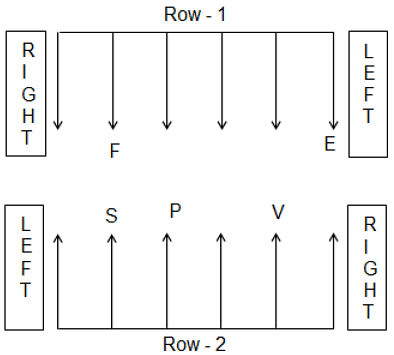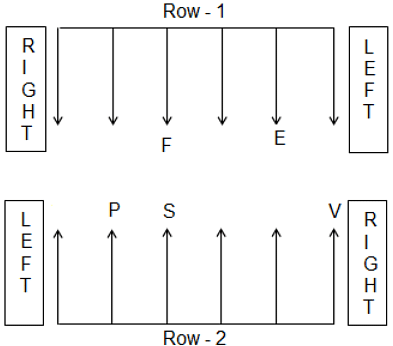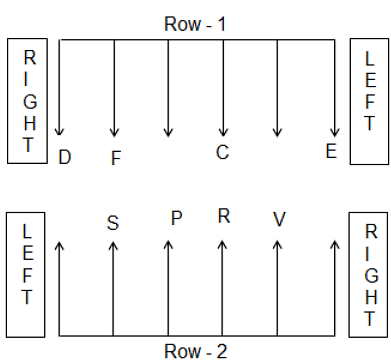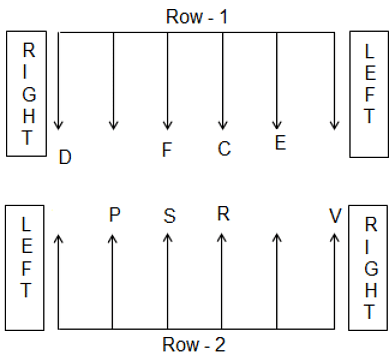SSC CGL Exam > SSC CGL Questions > Directions: Study the following information ...
Start Learning for Free
Directions: Study the following information to answer the given question.
Twelve people are sitting in two parallel rows containing six people each in such a way that there is equal distance between adjacent persons. In row-1, A, B, C, D, E and F are seated and all of them are facing south. In row-2, P, Q, R, S, T and V are seated and all of them are facing north. Therefore, in the given seating arrangement, each member, seated in a row, faces one member of the other row. V sits third to the right of S. S faces F and F does not sit at any of the extreme ends of the line. D sits third to the right of C. R faces C. The one facing E sits third to the right of P. B and P do not sit at the extreme ends of the line. T is not an immediate neighbour of V. A is not an immediate neighbour of C.
Q. How many persons are seated between R and T?
- a)One
- b)Two
- c)Three
- d)Four
Correct answer is option 'B'. Can you explain this answer?
| FREE This question is part of | Download PDF Attempt this Test |
Most Upvoted Answer
Directions: Study the following information to answer the given quest...
V sits third to the right of S. S faces F and F does not sit at any of the extreme ends of the line. The one facing E sits third to the right of P. B and P do not sit at the extreme ends of the line.




Possibility 1

Possibility 2

D sits third to the right of C. R faces C.
Possibility 1

Possibility 2

T is not an immediate neighbour of V. A is not an immediate neighbour of C. B and P do not sit at the extreme ends of the line. (Possibility 1 gets eliminated). Hence, the final arrangement will be as under

Two persons (P and S) are seated between R and T.
Free Test
FREE
| Start Free Test |
Community Answer
Directions: Study the following information to answer the given quest...
Steps to solve the problem:
1. Analyzing the given information:
- V sits third to the right of S.
- S faces F and F does not sit at any of the extreme ends of the line.
- D sits third to the right of C.
- R faces C.
- The one facing E sits third to the right of P.
- B and P do not sit at the extreme ends of the line.
- T is not an immediate neighbour of V.
- A is not an immediate neighbour of C.
2. Arranging the information:
- From the given information, we know that R faces C and the one facing E is third to the right of P. Therefore, E must be facing T because T is not an immediate neighbour of V.
- So, the arrangement becomes:
Row-1: A, B, C, D, E(T), F
Row-2: P, Q, R, S, T(E), V
3. Identifying the position of R and T:
- From the arrangement, we can see that R is second to the right of Q. Therefore, R is facing Q.
- T is facing E, who is to the immediate right of D. So, T is third to the right of D.
- Thus, the positions are:
Row-1: A, B, C, D(T), E, F
Row-2: P, Q, R, S, T, V
4. Calculating the number of persons between R and T:
- From the arrangement, we can see that there are 2 persons (S and T) between R and T.
Therefore, the correct answer is two persons seated between R and T.
1. Analyzing the given information:
- V sits third to the right of S.
- S faces F and F does not sit at any of the extreme ends of the line.
- D sits third to the right of C.
- R faces C.
- The one facing E sits third to the right of P.
- B and P do not sit at the extreme ends of the line.
- T is not an immediate neighbour of V.
- A is not an immediate neighbour of C.
2. Arranging the information:
- From the given information, we know that R faces C and the one facing E is third to the right of P. Therefore, E must be facing T because T is not an immediate neighbour of V.
- So, the arrangement becomes:
Row-1: A, B, C, D, E(T), F
Row-2: P, Q, R, S, T(E), V
3. Identifying the position of R and T:
- From the arrangement, we can see that R is second to the right of Q. Therefore, R is facing Q.
- T is facing E, who is to the immediate right of D. So, T is third to the right of D.
- Thus, the positions are:
Row-1: A, B, C, D(T), E, F
Row-2: P, Q, R, S, T, V
4. Calculating the number of persons between R and T:
- From the arrangement, we can see that there are 2 persons (S and T) between R and T.
Therefore, the correct answer is two persons seated between R and T.
Attention SSC CGL Students!
To make sure you are not studying endlessly, EduRev has designed SSC CGL study material, with Structured Courses, Videos, & Test Series. Plus get personalized analysis, doubt solving and improvement plans to achieve a great score in SSC CGL.

|
Explore Courses for SSC CGL exam
|

|
Similar SSC CGL Doubts
Directions: Study the following information to answer the given question.Twelve people are sitting in two parallel rows containing six people each in such a way that there is equal distance between adjacent persons. In row-1, A, B, C, D, E and F are seated and all of them are facing south. In row-2, P, Q, R, S, T and V are seated and all of them are facing north. Therefore, in the given seating arrangement, each member, seated in a row, faces one member of the other row. V sits third to the right of S. S faces F and F does not sit at any of the extreme ends of the line. D sits third to the right of C. R faces C. The one facing E sits third to the right of P. B and P do not sit at the extreme ends of the line. T is not an immediate neighbour of V. A is not an immediate neighbour of C.Q. How many persons are seated between R and T?a)Oneb)Twoc)Threed)FourCorrect answer is option 'B'. Can you explain this answer?
Question Description
Directions: Study the following information to answer the given question.Twelve people are sitting in two parallel rows containing six people each in such a way that there is equal distance between adjacent persons. In row-1, A, B, C, D, E and F are seated and all of them are facing south. In row-2, P, Q, R, S, T and V are seated and all of them are facing north. Therefore, in the given seating arrangement, each member, seated in a row, faces one member of the other row. V sits third to the right of S. S faces F and F does not sit at any of the extreme ends of the line. D sits third to the right of C. R faces C. The one facing E sits third to the right of P. B and P do not sit at the extreme ends of the line. T is not an immediate neighbour of V. A is not an immediate neighbour of C.Q. How many persons are seated between R and T?a)Oneb)Twoc)Threed)FourCorrect answer is option 'B'. Can you explain this answer? for SSC CGL 2024 is part of SSC CGL preparation. The Question and answers have been prepared according to the SSC CGL exam syllabus. Information about Directions: Study the following information to answer the given question.Twelve people are sitting in two parallel rows containing six people each in such a way that there is equal distance between adjacent persons. In row-1, A, B, C, D, E and F are seated and all of them are facing south. In row-2, P, Q, R, S, T and V are seated and all of them are facing north. Therefore, in the given seating arrangement, each member, seated in a row, faces one member of the other row. V sits third to the right of S. S faces F and F does not sit at any of the extreme ends of the line. D sits third to the right of C. R faces C. The one facing E sits third to the right of P. B and P do not sit at the extreme ends of the line. T is not an immediate neighbour of V. A is not an immediate neighbour of C.Q. How many persons are seated between R and T?a)Oneb)Twoc)Threed)FourCorrect answer is option 'B'. Can you explain this answer? covers all topics & solutions for SSC CGL 2024 Exam. Find important definitions, questions, meanings, examples, exercises and tests below for Directions: Study the following information to answer the given question.Twelve people are sitting in two parallel rows containing six people each in such a way that there is equal distance between adjacent persons. In row-1, A, B, C, D, E and F are seated and all of them are facing south. In row-2, P, Q, R, S, T and V are seated and all of them are facing north. Therefore, in the given seating arrangement, each member, seated in a row, faces one member of the other row. V sits third to the right of S. S faces F and F does not sit at any of the extreme ends of the line. D sits third to the right of C. R faces C. The one facing E sits third to the right of P. B and P do not sit at the extreme ends of the line. T is not an immediate neighbour of V. A is not an immediate neighbour of C.Q. How many persons are seated between R and T?a)Oneb)Twoc)Threed)FourCorrect answer is option 'B'. Can you explain this answer?.
Directions: Study the following information to answer the given question.Twelve people are sitting in two parallel rows containing six people each in such a way that there is equal distance between adjacent persons. In row-1, A, B, C, D, E and F are seated and all of them are facing south. In row-2, P, Q, R, S, T and V are seated and all of them are facing north. Therefore, in the given seating arrangement, each member, seated in a row, faces one member of the other row. V sits third to the right of S. S faces F and F does not sit at any of the extreme ends of the line. D sits third to the right of C. R faces C. The one facing E sits third to the right of P. B and P do not sit at the extreme ends of the line. T is not an immediate neighbour of V. A is not an immediate neighbour of C.Q. How many persons are seated between R and T?a)Oneb)Twoc)Threed)FourCorrect answer is option 'B'. Can you explain this answer? for SSC CGL 2024 is part of SSC CGL preparation. The Question and answers have been prepared according to the SSC CGL exam syllabus. Information about Directions: Study the following information to answer the given question.Twelve people are sitting in two parallel rows containing six people each in such a way that there is equal distance between adjacent persons. In row-1, A, B, C, D, E and F are seated and all of them are facing south. In row-2, P, Q, R, S, T and V are seated and all of them are facing north. Therefore, in the given seating arrangement, each member, seated in a row, faces one member of the other row. V sits third to the right of S. S faces F and F does not sit at any of the extreme ends of the line. D sits third to the right of C. R faces C. The one facing E sits third to the right of P. B and P do not sit at the extreme ends of the line. T is not an immediate neighbour of V. A is not an immediate neighbour of C.Q. How many persons are seated between R and T?a)Oneb)Twoc)Threed)FourCorrect answer is option 'B'. Can you explain this answer? covers all topics & solutions for SSC CGL 2024 Exam. Find important definitions, questions, meanings, examples, exercises and tests below for Directions: Study the following information to answer the given question.Twelve people are sitting in two parallel rows containing six people each in such a way that there is equal distance between adjacent persons. In row-1, A, B, C, D, E and F are seated and all of them are facing south. In row-2, P, Q, R, S, T and V are seated and all of them are facing north. Therefore, in the given seating arrangement, each member, seated in a row, faces one member of the other row. V sits third to the right of S. S faces F and F does not sit at any of the extreme ends of the line. D sits third to the right of C. R faces C. The one facing E sits third to the right of P. B and P do not sit at the extreme ends of the line. T is not an immediate neighbour of V. A is not an immediate neighbour of C.Q. How many persons are seated between R and T?a)Oneb)Twoc)Threed)FourCorrect answer is option 'B'. Can you explain this answer?.
Solutions for Directions: Study the following information to answer the given question.Twelve people are sitting in two parallel rows containing six people each in such a way that there is equal distance between adjacent persons. In row-1, A, B, C, D, E and F are seated and all of them are facing south. In row-2, P, Q, R, S, T and V are seated and all of them are facing north. Therefore, in the given seating arrangement, each member, seated in a row, faces one member of the other row. V sits third to the right of S. S faces F and F does not sit at any of the extreme ends of the line. D sits third to the right of C. R faces C. The one facing E sits third to the right of P. B and P do not sit at the extreme ends of the line. T is not an immediate neighbour of V. A is not an immediate neighbour of C.Q. How many persons are seated between R and T?a)Oneb)Twoc)Threed)FourCorrect answer is option 'B'. Can you explain this answer? in English & in Hindi are available as part of our courses for SSC CGL.
Download more important topics, notes, lectures and mock test series for SSC CGL Exam by signing up for free.
Here you can find the meaning of Directions: Study the following information to answer the given question.Twelve people are sitting in two parallel rows containing six people each in such a way that there is equal distance between adjacent persons. In row-1, A, B, C, D, E and F are seated and all of them are facing south. In row-2, P, Q, R, S, T and V are seated and all of them are facing north. Therefore, in the given seating arrangement, each member, seated in a row, faces one member of the other row. V sits third to the right of S. S faces F and F does not sit at any of the extreme ends of the line. D sits third to the right of C. R faces C. The one facing E sits third to the right of P. B and P do not sit at the extreme ends of the line. T is not an immediate neighbour of V. A is not an immediate neighbour of C.Q. How many persons are seated between R and T?a)Oneb)Twoc)Threed)FourCorrect answer is option 'B'. Can you explain this answer? defined & explained in the simplest way possible. Besides giving the explanation of
Directions: Study the following information to answer the given question.Twelve people are sitting in two parallel rows containing six people each in such a way that there is equal distance between adjacent persons. In row-1, A, B, C, D, E and F are seated and all of them are facing south. In row-2, P, Q, R, S, T and V are seated and all of them are facing north. Therefore, in the given seating arrangement, each member, seated in a row, faces one member of the other row. V sits third to the right of S. S faces F and F does not sit at any of the extreme ends of the line. D sits third to the right of C. R faces C. The one facing E sits third to the right of P. B and P do not sit at the extreme ends of the line. T is not an immediate neighbour of V. A is not an immediate neighbour of C.Q. How many persons are seated between R and T?a)Oneb)Twoc)Threed)FourCorrect answer is option 'B'. Can you explain this answer?, a detailed solution for Directions: Study the following information to answer the given question.Twelve people are sitting in two parallel rows containing six people each in such a way that there is equal distance between adjacent persons. In row-1, A, B, C, D, E and F are seated and all of them are facing south. In row-2, P, Q, R, S, T and V are seated and all of them are facing north. Therefore, in the given seating arrangement, each member, seated in a row, faces one member of the other row. V sits third to the right of S. S faces F and F does not sit at any of the extreme ends of the line. D sits third to the right of C. R faces C. The one facing E sits third to the right of P. B and P do not sit at the extreme ends of the line. T is not an immediate neighbour of V. A is not an immediate neighbour of C.Q. How many persons are seated between R and T?a)Oneb)Twoc)Threed)FourCorrect answer is option 'B'. Can you explain this answer? has been provided alongside types of Directions: Study the following information to answer the given question.Twelve people are sitting in two parallel rows containing six people each in such a way that there is equal distance between adjacent persons. In row-1, A, B, C, D, E and F are seated and all of them are facing south. In row-2, P, Q, R, S, T and V are seated and all of them are facing north. Therefore, in the given seating arrangement, each member, seated in a row, faces one member of the other row. V sits third to the right of S. S faces F and F does not sit at any of the extreme ends of the line. D sits third to the right of C. R faces C. The one facing E sits third to the right of P. B and P do not sit at the extreme ends of the line. T is not an immediate neighbour of V. A is not an immediate neighbour of C.Q. How many persons are seated between R and T?a)Oneb)Twoc)Threed)FourCorrect answer is option 'B'. Can you explain this answer? theory, EduRev gives you an
ample number of questions to practice Directions: Study the following information to answer the given question.Twelve people are sitting in two parallel rows containing six people each in such a way that there is equal distance between adjacent persons. In row-1, A, B, C, D, E and F are seated and all of them are facing south. In row-2, P, Q, R, S, T and V are seated and all of them are facing north. Therefore, in the given seating arrangement, each member, seated in a row, faces one member of the other row. V sits third to the right of S. S faces F and F does not sit at any of the extreme ends of the line. D sits third to the right of C. R faces C. The one facing E sits third to the right of P. B and P do not sit at the extreme ends of the line. T is not an immediate neighbour of V. A is not an immediate neighbour of C.Q. How many persons are seated between R and T?a)Oneb)Twoc)Threed)FourCorrect answer is option 'B'. Can you explain this answer? tests, examples and also practice SSC CGL tests.

|
Explore Courses for SSC CGL exam
|

|
Suggested Free Tests
Signup for Free!
Signup to see your scores go up within 7 days! Learn & Practice with 1000+ FREE Notes, Videos & Tests.
























